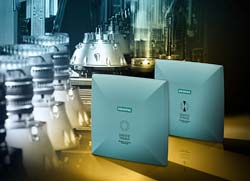Rugged components expand the field of application for RFID technology

The newly introduced products include antennas, a mobile reader, and extremely heat-resistant, compact data carriers in the Smart Label format. RFID systems that operate in the UHF range are successfully used in logistics, material handling and more and more in production due to their range of several meters. Their use provides transparency and therefore allows many processes in a company to be optimized. With extremely rugged components, Siemens contributes to the further spread of RFID technology in both proven and new application areas.
Two compact UHF antennas complete the comprehensive RFID product portfolio of the Siemens Industry Automation Division. The Simatic RF640A antenna with dimensions of 185 x 185 x 45 mm operates using circular polarization, whereas the RF642A model with the same dimensions uses linear polarization. Depending on the reader that is used, the range of the antennas can be up to four meters. Both antennas meet the high requirements of degree of protection IP67 and are designed for operating temperatures ranging from -25 to +75 degrees Celsius. Thus they are suitable for indoor and outdoor applications.
Another Siemens innovation is the Simatic RF680M mobile RFID reader. The reader includes a color display with VGA resolution (640×480 pixels) and an ergonomic keypad. The user benefits from the improved readability and can operate the device with only one hand due to the modified arrangement of the keys. Furthermore, the transmit power of the RFID module has been increased to 500 mW ERP (milliwatt; Effective Radiated Power), the CPU performance has been increased to 624 MHz, and the memory has been expanded to 1 GB Flash and 256 MB RAM in comparison to the predecessor model. The pre-installed RF600 software provides service and test functions for reading and writing on data carriers and Smart Labels. Recorded data can be saved and clearly arranged in file structures. An API library (Application Programming Interface) is also included. With these programming interfaces, the customer can create his own RFID applications for the mobile reader. Since RF680M uses the standard Windows CE operating system, the device can easily be integrated into existing IT networks and process infrastructures. With the high degree of protection IP65, the new reader is suitable for use in particularly harsh industrial environments such as production logistics or warehouse management.
In the field of RFID data carriers, Siemens is introducing the heat-resistant Simatic RF680L Smart Label. It can tolerate one hour at temperatures of up to 220 degrees Celsius or six hours at temperatures of up to 200 degrees Celsius and is therefore suitable for demanding industrial applications such as painting lines and other high-temperature applications. With the new Smart Label, the products can be permanently identified and tracked throughout the entire value creation chain in material handling, production, and logistics. The high memory capacity expands the application area of RF680L even more. The data carrier provides a memory capacity of 240 bits for the EPC (Electronic Product Code) and a further 512 bits for user data.
Siemens has been developing RFID systems for production and logistics for the last 25 years and is the market leader in Europe with more than 300,000 RFID read/write devices installed. The company provides optimized wireless data carriers along with the required software for various sectors and a wide variety of purposes – from RFID middleware to application software.
The Siemens Industry Sector (Erlangen, Germany) is the world's leading supplier of environmentally friendly production, transportation, building and lighting technologies. With integrated automation technologies and comprehensive industry-specific solutions, Siemens increases the productivity, efficiency and flexibility of its customers in the fields of industry and infrastructure. The Sector consists of six Divisions: Building Technologies, Drive Technologies, Industry Automation, Industry Solutions, Mobility and Osram. With around 207,000 employees worldwide Siemens Industry posted sales of about EUR35 billion in fiscal year 2009. http://www.siemens.com/industry
The Siemens Industry Automation Division (Nuremberg, Germany) is a global leader in the fields of automation systems, industrial controls and industrial software. Its portfolio ranges from standard products for the manufacturing and process industries to solutions for whole industrial sectors that encompass the automation of entire automobile production facilities and chemical plants. As a leading software supplier, Industry Automation optimizes the entire value added chain of manufacturers – from product design and development to production, sales and a wide range of maintenance services. With around 39,000 employees worldwide (September 30), Siemens Industry Automation achieved sales of €7.0 billion in fiscal year 2009. www.siemens.com/industryautomation
Reference Number: IIA2010112606e
Media Contact
More Information:
http://www.siemens.com/identAll latest news from the category: Machine Engineering
Machine engineering is one of Germany’s key industries. The importance of this segment has led to the creation of new university degree programs in fields such as production and logistics, process engineering, vehicle/automotive engineering, production engineering and aerospace engineering among others.
innovations-report offers informative reports and articles covering technologies such as automation, motion, power train, energy, conveyor, plastics, lightweight construction, logistics/warehousing, measurement systems, machine tools and control engineering.
Newest articles

Innovative 3D printed scaffolds offer new hope for bone healing
Researchers at the Institute for Bioengineering of Catalonia have developed novel 3D printed PLA-CaP scaffolds that promote blood vessel formation, ensuring better healing and regeneration of bone tissue. Bone is…

The surprising role of gut infection in Alzheimer’s disease
ASU- and Banner Alzheimer’s Institute-led study implicates link between a common virus and the disease, which travels from the gut to the brain and may be a target for antiviral…

Molecular gardening: New enzymes discovered for protein modification pruning
How deubiquitinases USP53 and USP54 cleave long polyubiquitin chains and how the former is linked to liver disease in children. Deubiquitinases (DUBs) are enzymes used by cells to trim protein…



